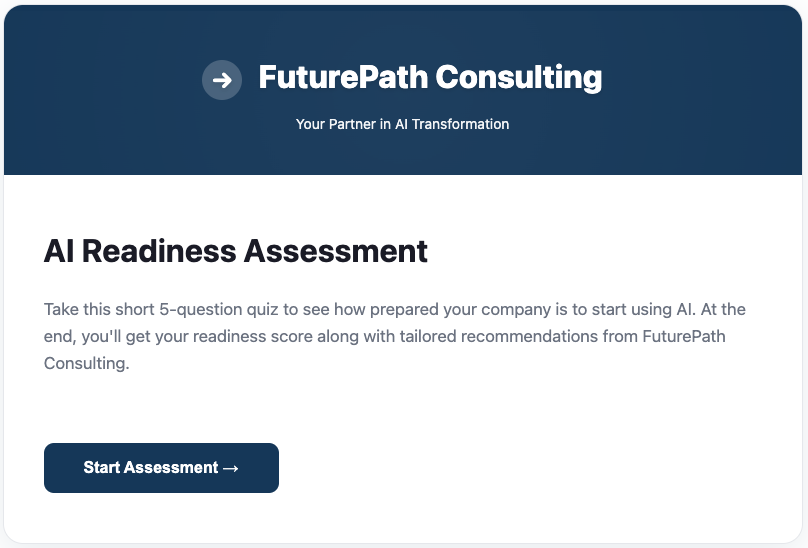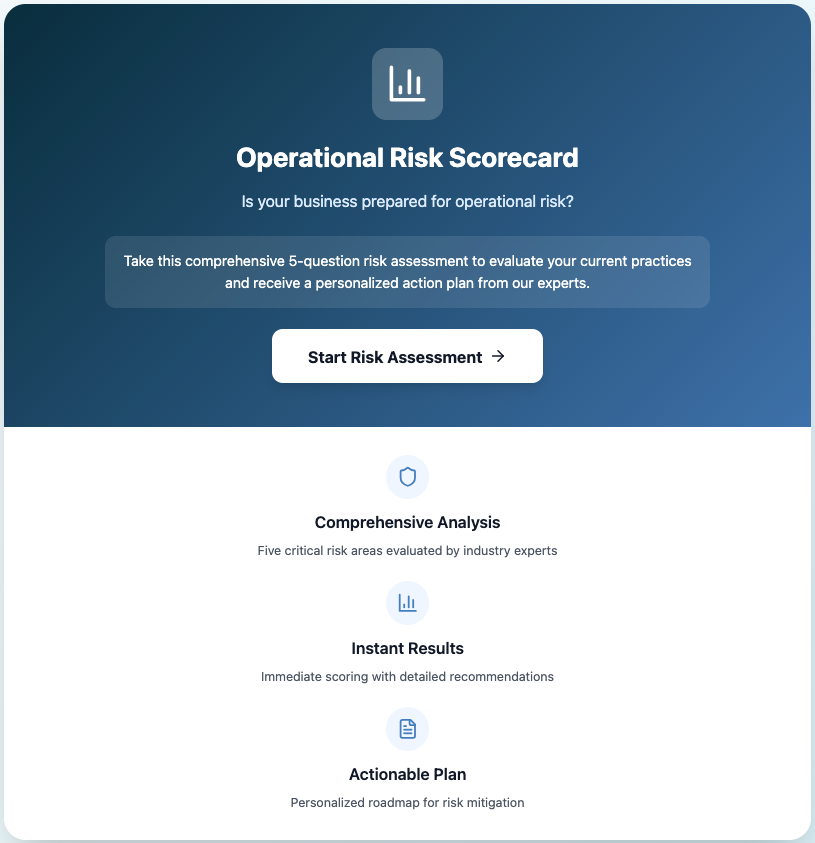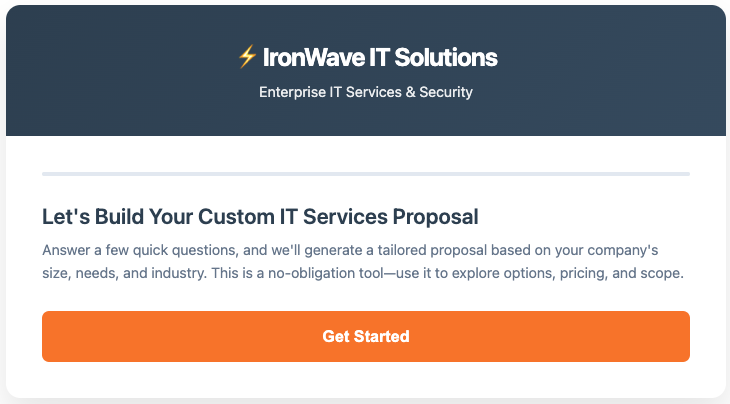
As AI reshapes the way people search and interact online, traditional marketing tactics are losing their edge. SEO is getting harder. Organic traffic is shrinking. Static content just doesn’t convert like it used to.
Building interactive content with vibe coding is one way to break through. This isn’t coding in the traditional sense. It’s an easy way to build custom, interactive tools like quizzes, ROI calculators, and checklists, with natural language.
With no programming experience required, you can create marketing tools that generate leads, qualify prospects, and move users down the funnel.
Just describe the app you want in plain language, and AI platforms like Claude build it for you. Create in just a few minutes, refine through back-and-forth prompts, test it live, and hand off to your dev team to launch.
It’s a whole new way for marketers to go from idea to working asset—in minutes instead of months.
What Is Vibe Coding?
Vibe coding is a lightweight, conversational approach to building apps. (As of this writing, Claude.ai does vibe coding the best.) Now marketers, creators, and even non-technical users can build functional prototypes and tools quickly—with natural language.
The Benefits of Vibe Coding
Interactive tools don’t just look cool; they drive real marketing results. When done well, they outperform static content in nearly every metric that matters.
- Longer time on site: Interactive experiences keep users engaged and exploring.
- Higher conversion rates: Interactive content, such as apps, assessments, calculators, configurators and quizzes, generate conversions moderately or very well 70% of the time, compared to just 36% for passive content.
- Better lead qualification: Capture meaningful data as users interact with your tool, then pass it to your CRM or sales team.
- Shareable experiences: People are more likely to share a quiz result or calculator than a blog post. That means more visibility and organic traffic.
- Stronger differentiation: Interactive tools show you do, not just say, which sets your brand apart from competitors stuck in the content marketing past.
- Early adopter advantage. Only 25% of participants in the study above rated their content as slightly or very interactive, making interactive content a huge area of opportunity.
For marketers, interactive apps are strategic assets that work 24/7 to attract, engage, and convert.
Getting Started with Vibe Coding
To start, you’ll need access to Claude.ai. (As of this writing, Claude does vibe coding the best.) For most simple projects, all you need is a clear description of your idea.
Think of it like asking a graphic designer to sketch something for you. You describe, they draw, you refine. With Claude, you describe, it generates code, and you test and tweak.
Step-by-Step Guide
You don’t need to be a developer—or even know how to code—to build an interactive app with Claude. Just follow these steps to go from idea to working prototype in minutes.
Step 1: Define what you want the app to do
Write a one- or two-sentence description of what the app should do (e.g. “A 5-question quiz to recommend the right product”).
Step 2: Prompt Claude
Include product details in your initial prompt. Give Claude your app description and add a bullet list or short paragraph with your product info (or upload existing sales material).
For example:
“Build a 5-question quiz that recommends one of our three products based on answers.
Here are the products:
- Product A: For small teams that need basic automation
- Product B: For growing teams that want integrations
Product C: For enterprise clients needing advanced features and support”
Step 3: Tell Claude how the logic should work
If you have a clear idea of how you want your tool structured, be as specific as you can. Do you want it to total points? Display a message at the end? Ask for those features directly.
If you don’t have a clear idea, let Claude suggest logic and scoring criteria, which you can then edit and refine.
After you’ve entered all your data, Claude will write the code for your app in just a minute or two.
Congratulations—you now have a working prototype to hand off to your dev team.
Step 4: Refine through back-and-forth prompts
If it’s not perfect on the first try (and it rarely is), just ask for tweaks:
- “Please add a progress bar.”
- “Make it mobile-friendly.”
- “Add a link to our website at the bottom.”
This iterative loop is what makes vibe coding so powerful. You don’t need to know how to fix bugs. You only have to ask for improvements.
Step 5: Customize and brand it
Once the core functionality works, layer on your brand elements:
- Fonts and colors from your website
- Custom images or icons
- Links to your product pages or lead-gen forms
Even if you’re not a designer, Claude can help here, too. Just say, “Please style using my brand’s blue and add our logo.” AI tools respond especially well to color codes, so use them to be sure they match your brand exactly. Better still, upload your brand’s style guide.
Step 6: Publish and share
Once you’re happy with your app, you can:
- Embed it on your website
- Share it as a standalone tool
- Use it in a campaign landing page
Tools like Netlify or Vercel make it easy to publish apps with a free account. Or you can pass it along to your developer to add to website pages or embed in blogs.
Bonus tip: Once you have a working Claude prompt, save it as a template to use later. You can reuse the same format to create:
- Variations for different products
- Language-specific versions
- New quizzes, calculators, or tools
Think of it as a reusable marketing asset—just like an email template or landing page copy.
Five Vibe Coding Marketing Examples
We’ve created five easy-to-build apps to demonstrate the range of what’s possible with vibe coding. We built each one by describing what we wanted to Claude, then refining the result through follow-up prompts.
Keep in mind these are meant to be prototypes only. You can easily add your brand style and colors and tweak the interface to make them beautiful tools that fit perfectly with your company’s vibe (so to speak!).
We’ve embedded working versions of all five apps, so try them out!
1. Product Picker
Ready to Transform Your Workflow?
Answer 5 quick questions and we’ll recommend the ideal FlowTrack plan for your team. It only takes 30 seconds!
How big is your team?
How much do you rely on automation to save time?
Which best describes your storage and file-sharing needs?
What level of reporting and analytics do you need?
What kind of support does your team expect?
Your Perfect Plan
Based on your responses, here’s what we recommend:
What’s Included:
FlowTrack is a fictional company that specializes in providing intelligent workflow solutions for teams and organizations looking to streamline their business processes. The company positions itself as a smart alternative to manual, disjointed workflows by offering data-driven recommendations tailored to specific organizational needs.
They might create a Product Picker to help potential customers decide which FlowTrack plan is the right fit for them.
2. ROI calculator
See Your Team’s ROI with CollabCloud
Enter a few quick details and find out how much time and money you’ll save.
Input
Results
A SaaS company can build an ROI calculator to help users see how much they could save with the company’s product or services. For a project like this, you would need to add company metrics to your prompt.
For example, if you know that your product typically saves users 5 hours per month per team member, give Claude that information in your prompt.
3. Sales qualifier app
The fictional FuturePath Consulting is an advisory firm that helps mid-size businesses adopt and integrate AI tools into their operations. They focus on AI readiness assessments, workflow automation planning, and training programs for non-technical staff.
They might use the following AI readiness assessment as a sales qualifier tool.
4. Risk assessment survey
5. Smart proposal builder
The fictional IronWave is an IT services firm that provides managed IT, cloud migrations, cybersecurity, and compliance solutions for businesses with 20–500 employees.
The operational risk scoreboard is a great marketing tool for a cybersecurity, compliance, finance, or legal company.
Vibe Coding for Lead Generation
Interactive apps make perfect lead-gen assets. Here are some ways to use them.
- Add a lead capture form: At the end of the quiz or calculator, prompt Claude to add a simple form that collects name and email. For example:
“Add a button at the end that opens the user’s email client. Pre-fill the subject with ‘My Results’ and the body with their results. Send it to [email protected].”
- Gate the results: If you’d like users to enter their email before seeing their result or recommendation, ask:
“Display a form before the result appears. Show the result after the user enters their email.”
- Use it on a landing page: Embed the app into a standalone page that includes a call-to-action, explanation of the value, and a sidebar form. Great for ads and social campaigns.
This turns your interactive app into a true marketing asset—one that not only engages visitors, but also captures them.
Bonus tip: Save your prompt as a template
Once you have a working Claude prompt, save it for later use. You can modify and reuse the same prompt to create:
- Variations for different products
- Language-specific versions
- New quizzes, calculators, or tools
Think of it as a reusable marketing asset—just like an email template or landing page copy.
Best Practices for Vibe Coding
- Start small. Begin with a simple app like the ones in this article and let Claude handle the basics before layering on complexity.
- Iterate quickly. Don’t expect a perfect build in one go. Prompt, test, and refine.
- Be conversational but precise. The more clearly you describe what you want, the better the output.
- Leverage Claude’s feedback. If the app breaks, ask Claude how to fix it—it often explains its reasoning as well as the solution.

Marketer Takeaways
- Vibe coding is a way to move ideas off the whiteboard and into action—without waiting on a dev team.
- SEO is evolving—interactive tools help you stand out and drive traffic.
- Vibe coding lets marketers build apps like quizzes and calculators with no coding skills required.
- Claude generates working prototypes in minutes based on natural language prompts.
- Interactive apps convert better, keep users engaged, and qualify leads automatically.
- You can customize and brand these tools, then embed them on your site or landing pages.
- Use them as lead magnets by gating results or capturing emails at the end.
- Vibe-coded apps are fast, scalable, and reusable—perfect for modern marketing teams.
Let Us Build One for You
Love the idea but don’t have time to create one yourself? We specialize in building smart, interactive tools—like proposal generators, ROI calculators, and readiness assessments—that turn visitors into qualified leads.
The Media Shower AI platform: More marketing. Less coding. Click here for a free trial.




